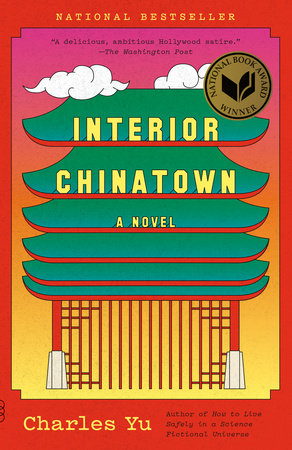
Welcome back! If you’re looking to ring in the new year and the new semester with some new reading material, we at the library have got you covered. This month, as always, we’re highlighting a selection of titles from our New & Noteworthy and Overdrive collections. The below titles represent only a very small sampling of what these collections hold, however, so we encourage you to explore them in full to discover your next read.
Interior Chinatown by Charles Yu. In this novel, Westworld writer Yu tells the story—in the format of a screenplay—of Willis Yu, an aspiring Hollywood actor who continually finds himself limited to menial, racist roles such as “Background Oriental Male” and “Delivery Guy.” Frustrated with the entertainment industry’s pigeonholing of Asian actors, Willis is determined to land a more glamorous part, striving to eventually be cast as “Kung Fu Guy” even though such a role still easily falls under Hollywood’s stereotypical envisioning of Asian characters. Interspersed with Willis’ work as an actor are scenes in which he interacts with a number of other compelling characters, including his father Sifu and his fellow actors. Through the character of Willis, the characters surrounding him, and the screenplay format, Charles Yu crafts a searing and exceedingly humorous satire of the modern-day entertainment industry and its racism, one which ultimately won last year’s National Book Award for Fiction. You can read reviews here and here.

Administrations of Lunacy: Racism and the Haunting of American Psychiatry at the Milledgeville Asylum by Mab Segrest. In this book, activist Segrest describes her investigation of the records of Central State Hospital in Milledgeville, Georgia, a psychiatric hospital that opened in 1842 and closed in 2010. While the hospital has developed a notorious reputation for its well-known history of patient mistreatment, Segrest focuses on its particularly egregious abuse of Black patients, who were first admitted into segregated quarters of the hospital following the end of the Civil War. In addition to drawing attention to the inferior conditions these patients endured relative to white patients as a result of de jure and later de facto segregation, Segrest also delves into the records of individual Black patients to contextualize their various diagnoses and treatments with the long history of racism in American psychiatric research and practice. She discusses at length the way in which disability and mental illness diagnoses were weaponized against Black patients in particular, as well as the disturbing frequency with which they were subjected to forced sterilization and other treatments influenced by the burgeoning eugenics movement. In all, the book serves as an important study of the intersection of white supremacy and ableism, and proves highly relevant to the way this intersection plays out today. That said, much of the book’s content is decidedly graphic, something potential readers should consider. You can read reviews here and here.

Monogamy by Sue Miller. In this novel, bestselling author Miller focuses on Annie, a middle-aged photographer in Cambridge, Massachusetts, who has suddenly lost her husband of 30 years, bookstore owner Graham. When Graham was alive, he and Annie often appeared be an odd couple to those around them, with Annie’s small size and reserved character contrasting quite sharply with Graham’s vast physical presence and bon vivant personality. Yet Annie herself was generally happy in the marriage, despite occasional tensions, but her love and mourning for Graham following his passing is quickly marred by the sudden realization that he had been having an affair before his death. In what follows, Annie finds herself reassessing their relationship, and embarks on a journey to find peace with what they had—and did not have—together. While the examination of the marriage makes for a fascinating story on its own, Miller supplements Annie’s perspective with the insightful perspectives of key side characters, such as Annie and Graham’s adult daughter, Sarah, and Graham’s first wife, Frieda. You can read reviews here and here.

My Baby First Birthday by Jenny Zhang. In this poetry collection, poet and essayist Zhang examines issues of identity—and being born into a specific identity—that prove to be long-lasting, and essentially timeless, in a given person’s life. Over the course of the collection’s 97 poems, Zhang touches on several iterations of these identities, such as her mother’s womanhood and her own life as an Asian woman in a world that values whiteness, the suffering that derives from the perennial expectations placed upon these identities, and the desired and sometimes attainable liberation from such suffocating expectations (“be the baby ppl didn’t let u be / for once in yr life / & see what happens”). Zhang’s observations on identity are not entirely interior, however, as she also casts a light on the reader, inviting them to make the same considerations she is making about herself. Though this focus on identity is present throughout the whole of the collection, there are a number of interesting intersections with other subjects, most notably Zhang’s conception of her own sexuality. Through its use of overwhelming emotions, the collection makes for a memorable read. You can read reviews here and here.

The Fabric of Civilization: How Textiles Made the World by Virginia Postrel. In this book, journalist Postrel puts forth the argument that each and every piece of fabric produced in human history reveals key information about the life, experiences, and desires of the person who made it, and that, when assembled together, all of the textiles and fabrics ever produced form an invaluable tapestry that tells the story of human history. In making this assertion, Postrel writes an engrossing account of the history of fabric, one that is occasionally overwhelming in its scope, but always compelling. Beginning in Bronze Age Crete and ending with the modern-day US, the examination of this history—which also accounts for the individual histories of different fabrics like wool and linen—extends to a myriad of cultures and places, including Egypt, China, Mexico, England, and Italy, among others. In the midst of this survey are several close-ups on individual processes and people, and these sections, along with the many helpful diagrams that Postrel employs, help enliven and personalize the broad account that she conveys. Overall, the book provides a vivid history of an often overlooked—yet essential—element of the human experience. You can read reviews here and here.


